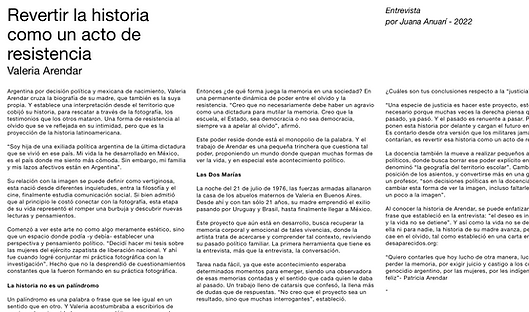


Valeria Arendar et Eleana Konstantellos, fondatrices du collectif Melka en 2022, s’intéressent aux histoires de l’espionnage qui a opéré sur le sol mexicain durant la guerre froide. Dans The Dice Was Loaded From The Start, elles explorent les fragments d’intrigues et de jeux de pouvoir et tentent de mettre en images ce qui a longtemps été dissimulé. Pour ce faire, les deux photographes sont parties de l’opération LITEMPO, menée par la CIA au Mexique, dans le but de contrer l’influence soviétique et les mouvements de gauche. Rencontre.
%208_30_43%E2%80%AFp_m_.png)

The Dice Was Loaded from the Start is a project by visual artists Valeria Arendar and Eleana Konstantellos. It explores Mexico City as an epicenter of espionage during the Cold War.

Chiquilla te quiero is a printed art publication dedicated to researching and disseminating the active components of the contemporary phenomenon in Mexico and Latin America. Our name is taken from a popular song that reflects the three main pillars of the magazine

Mexican photographer Valeria Arendar re-enacts her mother’s escape from Argentina during the military repression in the 1970s. Driven by her mother’s recollections and collective memories, Valeria creates haunting images that portray the distress of fearing for one’s life and safety.
%2010_58_43.png)
Fascinated by the traces of the visible, the invisible, and the disarticulation of memory, Argentine-Mexican photographer Valeria Arendar, 27, delves into her mother’s story. A former activist, her mother was forced to flee her native Argentina and its dictatorship to survive. Through Two Times Mary, Arendar weaves a metaphorical narrative where symbols challenge more concrete memories, amidst military violence, torture, extermination, and activism.
%207_47_11%E2%80%AFp_m_.png)
Argentinian by political decision and Mexican by birth, Valeria Arendar intertwines her mother’s biography with her own. She offers an interpretation rooted in the territory that sheltered her story, using photography to recover the testimonies silenced by others.

We talked with Valeria Arendar about her photographic projects, her processes, and, above all, the practice of exercising imagination.

Arendar shares her journey, influences, and creative processes, highlighting her project Two Times Mary, which addresses her family's exile during the Argentine military dictatorship and reflects on the construction of memory and identity.


Valeria explores the boundaries between fiction and collective memory. Her project Two Times Mary seeks to recover the bodily and emotional memories triggered on the night her family was exiled to Mexico as a consequence of the Argentine military dictatorship.

We explored with Valeria Arendar the idea behind rejected, abandoned, and hidden shots. Let’s try asking yourself: why does a picture get discarded?

The first solo show by Valeria Arendar will open next Friday, 16th October as a result of the Intersection Exhibition Prize offered jointly by PhMuseum and the Italian gallery. The Mexican photographer is the winner of the first edition of PhMuseum free open call Intersection Exhibition Prize, a new proposal aimed at giving visibility to authors while developing new connections between them and artistic institutions.

In ‘On Body and Soul’ selected artists explore new ways of engaging with others by questioning and experimenting with the medium. Valeria Arendar portrays the distress of fearing for one’s life and safety, driven by her mother’s recollections and collective memories.


It's time for a recap! By shining a spotlight on eight female photojournalists, Women War Photographers restores glory to unsung heroines. A feminist reflection that Clélia Odette Rochat strives to convey through bodies, with a tenderly unconventional perspective. Along the paths of exile and military violence, Maryam Firuzi and Valeria Arendar pay tribute to their respective legacies.

Every historical moment has its battlefields, but on both sides, the same ones are always present. It’s a daunting task to think/produce photographs when your eyes burn, your body aches, or you’re forced out of your job. Like modern-day troubadours, we will carry our latent images on our backs, going from town to town, side to side, telling and revealing our craft of resistance.

The series ‘Two Times Mary’ is a series that seeps out of the subconscious, it is a beautiful; melancholic and mournful representation of memory; pain and loss. The pace of the work flows gently but there is an unnerving ambiguity and subtle absence suggested, as if what we see is not what we are looking for – we’re not sure what it is and yet it might just be out of sight – all of these motifs condense into the series.

"Anita lava la tina" or "Dábale arroz a la zorra el abad" are clever palindromes, it's true, as all of them are simply by being what they are. But Valeria Arendar isn't satisfied with just that; she wants them to also be poetic. And hers undoubtedly are.

Nineteen essays, sketches, possible conclusions, and explorations of various research themes, touching on the collective and the singular proposed by the educational—and therefore creative—space. This exhibition is also a continuous effort to nourish, question, refine, set aside, propose, err, and doubt. A work carried out through thought that traverses the body and the body that shapes perspectives through the image as material. As a process, what is exhibited here does not present conclusions but rather findings and suspicions—engines for both the creators and their viewers. A group, collective, circular dynamo.

Grandmama's Print Magazine is a publication about contemporary photography. For Valeria Arendar, to articulate the past historically does not mean "to know it as it truly was." It means seizing a memory as it flashes in a moment of danger.